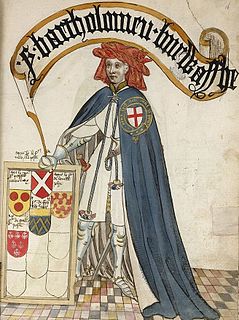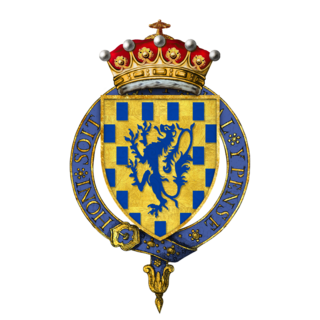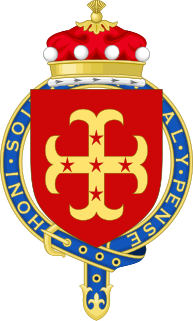
The Most Noble Order of the Garter is an order of chivalry founded by Edward III of England in 1348. It is the most senior order of knighthood in the British honours system, outranked in precedence only by the Victoria Cross and the George Cross. The Order of the Garter is dedicated to the image and arms of Saint George, England's patron saint.

Thomas Holland, 2nd Baron Holand, and jure uxoris1st Earl of Kent, KG was an English nobleman and military commander during the Hundred Years' War. By the time of the Crécy campaign, he had apparently lost one of his eyes.

The Most Honourable Order of the Bath is a British order of chivalry founded by George I on 18 May 1725. The name derives from the elaborate medieval ceremony for appointing a knight, which involved bathing as one of its elements. The knights so created were known as "Knights of the Bath". George I "erected the Knights of the Bath into a regular Military Order". He did not revive the Order of the Bath, since it had never previously existed as an Order, in the sense of a body of knights who were governed by a set of statutes and whose numbers were replenished when vacancies occurred.

Sir Roger de Mortimer, 2nd Earl of March, 4th Baron Mortimer of Wigmore, KG was an English nobleman and military commander during the Hundred Years' War.

Sir John Chandos, Viscount of Saint-Sauveur in the Cotentin, Constable of Aquitaine, Seneschal of Poitou, was a medieval English knight who hailed from Radbourne Hall, Derbyshire. Chandos was a close friend of Edward the Black Prince and a founding member and 19th Knight of the Order of the Garter in 1348. Chandos was a gentleman by birth, but unlike most commanders of the day he held no inherited title of nobility.

Sir James Audley KG was one of the original knights, or founders, of the Order of the Garter. He was the eldest son of Sir James Audley of Stratton Audley in Oxfordshire.

Bartholomew Burghersh, 2nd Baron Burghersh KG, called 'the younger', was an English nobleman and soldier.

Sir George Rothe Bellew,, styled The Honourable after 1935, was a long-serving herald at the College of Arms in London. Educated at the University of Oxford, he was appointed Portcullis Pursuivant in 1922. Having been Somerset Herald for 24 years, he was promoted to the office of Garter Principal King of Arms in 1950, the highest heraldic office in England and Wales. He served in that capacity until his resignation in 1961. As Garter, Bellew oversaw the funeral of George VI, proclaimed the late King's daughter, Elizabeth II, as Queen and took a leading role in the organisation of her Coronation in 1953. After his retirement, Bellew was Secretary of the Order of the Garter and Knight Principal of the Imperial Society of Knights Bachelor. He lived for many years at Dower House in Old Windsor, Berkshire, but later moved to Farnham and died in 1993, aged 93.

St George's Chapel at Windsor Castle in England is a castle chapel built in the late-medieval Perpendicular Gothic style. It is both a Royal Peculiar and the Chapel of the Order of the Garter. St George's Chapel was founded in the 14th century by King Edward III and extensively enlarged in the late 15th century. It is located in the Lower Ward of the castle. The castle has belonged to the monarchy for almost 1000 years and it is a principal residence of Queen Elizabeth II. The chapel has been the scene of many royal services, weddings and burials — in the 19th century, St George's Chapel and the nearby Frogmore Gardens superseded Westminster Abbey as the chosen burial place for the British royal family.

Sir Walter Paveley KG (1319–1375) was an English knight from Kent, a Knight Founder of the Order of the Garter. He was the son of Sir Walter Paveley, a Kentish landholder, and Maud, daughter and heir of Sir Stephen Burghersh, the elder son of Robert Burghersh.

Guichard (IV) d'Angle, Earl of Huntingdon, KG was a Poitevin knight, a Knight of the Garter and a companion of Edward the Black Prince. He was born in a noble family from Angles-sur-l'Anglin in North-Eastern Poitou, sometime between 1305 and 1315.

Sir Bryan Stapleton KG was an English medieval knight from Yorkshire.

Thomas Ughtred, 1st Baron Ughtred, KG was an English soldier and politician. The eldest son and heir of Robert Ughtred, lord of the manor of Scarborough, Kilnwick Percy, Monkton Moor, and other places in Yorkshire. He was born in 1292, being eighteen years of age at his father's death, before 24 May 1310. During a distinguished career he was knighted in 1324, made a Knight banneret in 1337, a Knight of the garter between 15 May 1358 and 1360, and summoned to parliament as Baron Ughtred on 30 April 1344.

Sir Hugh Courtenay, KG, was the eldest son and heir apparent of Hugh Courtenay, 10th Earl of Devon (1303–1377), whom he predeceased, and was a founding member of the Order of the Garter.

Sir Thomas Banastre KG was a Knight of the Garter from England.

Sir Neil Loring, KG, was a medieval English soldier and diplomat and a founding member of the Order of the Garter, established by King Edward III in 1348. The central character in two historical novels by Sir Arthur Conan Doyle, Sir Nigel and The White Company, is loosely based on Neil Loring.

The Holland family was a medieval-era English noble family. Many Hollands were Earls, Dukes, Knights and Barons in medieval England, and they played significant roles in the struggles for the crown in fourteenth and fifteenth century.

William Montagu, 2nd Earl of Salisbury, 4th Baron Montagu, King of Mann, KG was an English nobleman and commander in the English army during King Edward III's French campaigns in the Hundred Years War. He was one of the Founder Knights of the Order of the Garter.



















